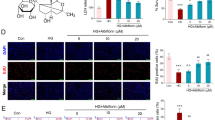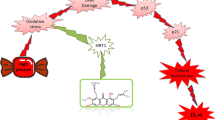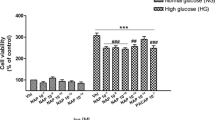Abstract
Objective
To study the toxicity features of high glucose on the endothelial cell cycle and the influence of Dan Gua-Fang (丹瓜方), a Chinese herbal compound prescription, on the reproductive cycle of vascular endothelial cells cultivated under a high glucose condition; to reveal the partial mechanisms of Dan Gua-Fang in the prevention and treatment of endothelial injury caused by hyperglycemia in diabetes mellitus (DM); and offer a reference for dealing with the vascular complications of DM patients with long-term high blood glucose.
Methods
Based on the previous 3-(4,5)-dimethylthiahiazo (z-y1)-3–5-diphenytetrazoliumromide (MTT) experiment, under different medium concentrations of glucose and Dangua liquor, the endothelial cells of vein-304 (ECV-304) were divided into 6 groups as follows: standard culture group (Group A, 5.56 mmol/L glucose); 1/300 herb-standard group (Group B); high glucose culture group (Group C, 16.67 mmol/L glucose); 1/150 herb-high glucose group (Group D); 1/300 herb-high glucose group (Group E); and 1/600 herb-high glucose group (Group F). The cell cycle was assayed using flow cytometry after cells were cultivated for 36, 72 and 108 h, respectively.
Results
(1) The percentage of cells in the G0/G1 phase was significantly increased in Group C compared with that in Group A (P<0.05), while the percentage of S-phase (S%) cells in Group C was significantly reduced compared with Group A (P<0.05); the latter difference was dynamically related to the length of growing time of the endothelial cells in a high glucose environment. (2) The S% cells in Group A was decreased by 30.25% (from 40.23% to 28.06%) from 36 h to 72 h, and 12.33% (from 28.06% to 24.60%) from 72 h to 108 h; while in Group C, the corresponding decreases were 23.05% and 21.87%, respectively. The difference of S% cells between the two groups reached statistical significance at 108 h (P<0.05). (3) The percentage difference of cells in the G2/M phase between Group C and Group A was statistically significant at 72 h (P<0.01). (4) 1/300 Dan Gua-Fang completely reversed the harmful effect caused by 16.67 mmol/L high glucose on the cell cycle; moreover it did not disturb the cell cycle when the cell was cultivated in a glucose concentration of 5.56 mmol/L.
Conclusions
High glucose produces an independent impact on the cell cycle. Persistent blocking of the cell cycle and its arrest at the G0/G1 phase are toxic effects of high glucose on the endothelial cell cycle. The corresponding variation of the arrest appears in the S phase. 1/300 Dan Gua-Fang completely eliminates the blockage of high glucose on the endothelial cell cycle.
Similar content being viewed by others
References
Heng XP, Chen KJ, Hong ZF, He WD, Chu KD, Chen WL, et al. Glucose endothelial cytotoxicity and protection of Dan Gua-Fang, a Chinese herb prescription in huVEC in hyperglycemia medium. J Diabetes Complicat 2009;23:297–303.
Heng XP, Chen KJ. Intensive diabetic treatment and vasculopathy (II). Chin J Integr Tradit West Med (Chin) 2008;28:669–672.
Heng XP, Chen KJ. Intensive diabetic treatment and vasculopathy (I). Chin J Integr Tradit West Med (Chin) 2008;28:563–566.
Heng XP, Chen KJ, Hong ZF, He WD, Chu KD, Chen WL, et al. Research on ROS content variance of inner-ECV 304 in high glucose medium and influence of Dangua. Guangming Tradit Chin Med (Chin) 2008;23:551–555.
Bogdanski P, Pupek-Musialik D, Dytfeld J, Jagodzinski PP, Jablecka A, Kujawa A, et al. Influence of insulin therapy on expression of chemokine receptor CCR5 and selected inflammatory markers in patients with type 2 diabetes mellitus. Int J Clin Pharmacol Ther 2007;45:563–567.
Csiszar A, Ungvari ZI. Endothelial dysfunction and vascular inflammation in type II diabetes: interaction of AGE/RAGE and TNF-alpha signaling. Am J Physiol Heart Circ Physiol 2008;295:H475–H476.
Lorenzi M, Cagliero E, Toledo S. Glucose toxicity for human endothelial cells in culture. Delayed replication, disturbed cell cycle, and accelerated death. Diabetes 1985;34:621–627.
Heng XP, Chen KJ, Hong ZF, He WD, Chu KD, Chen WL, et al. Anticolchicine cytotoxicity enhanced by Dan Gua-Fang, a Chinese herb prescription in ECV304 in mediums. Chin J Integr Med 2011;17:126–133.
Ling HY, Hu B, Wang BX, Zu XY, Feng SD, Ou HS, et al. Effects of rosiglitazone on the proliferation of vascular smooth muscle cell induced by high glucose. Cardiovasc Drugs Ther 2008;22:453–460.
Cai J, Kehoe O, Smith GM, Hykin P, Boulton ME. The angiopoietin/Tie-2 system regulates pericyte survival and recruitment in diabetic retinopathy. Invest Ophthalmol Vis Sci 2008;49:2163–2171.
Lan CC, Liu IH, Fang AH, Wen CH, Wu CS. Hyperglycaemic conditions decrease cultured keratinocyte mobility: implications for impaired wound healing in patients with diabetes. Br J Dermatol 2008;159:1103–1115.
Asija A, Peterson SJ, Stec DE, Abraham NG. Targeting endothelial cells with heme oxygenase-1 gene using VE-cadherin promoter attenuates hyperglycemiamediated cell injury and apoptosis. Antioxid Redox Signal 2007;9:2065–2074.
Ejaz S, Chekarova I, Ejaz A, Sohail A, Lim CW. Importance of pericytes and mechanisms of pericyte loss during diabetes retinopathy. Diabetes Obes Metab 2008;10:53–63.
Nisoli E, Cozzi V, Carruba MO. Amino acids and mitochondrial biogenesis. Am J Cardiol 2008;101(11A):22E–25E.
Burnstock G. Dual control of vascular tone and remodelling by ATP released from nerves and endothelial cells. Pharmacol Rep 2008;60:12–20.
Keymel S, Kalka C, Rassaf T, Yeghiazarians Y, Kelm M, Heiss C. Impaired endothelial progenitor cell function predicts age-dependent carotid intimal thickening. Basic Res Cardiol 2008;103:582–586.
Onuta G, Westerweel PE, Zandvoort A, van Riezen M, Rozing J, Hillebrands JL, et al. Angiogenic sprouting from the aortic vascular wall is impaired in the BB rat model of autoimmune diabetes. Microvasc Res 2008;75:420–425.
Wu-Wong JR. Endothelial dysfunction and chronic kidney disease: treatment options. Curr Opin Investig Drugs 2008;9:970–982.
Heng XP. Strategies and methods for the treatment of diabetic neuropathy using integrative Chinese and Western medicine. Chin J Integr Med 2008;14:245–247.
Author information
Authors and Affiliations
Corresponding author
Additional information
Supported by the Post-doctoral Science Funds of China (No. 20070410128), CHEN Ke-ji Development Fund of Integrative Medicine (No. CKJ2006001) and Science Fund of Health Department of Fujian Province, China (No. WZY0618)
Rights and permissions
About this article
Cite this article
Heng, Xp., Chen, Kj., Hong, Zf. et al. Toxicity features of high glucose on endothelial cell cycle and protection by Dan Gua-Fang (丹瓜方) in ECV-304 in high glucose medium. Chin. J. Integr. Med. 19, 596–602 (2013). https://doi.org/10.1007/s11655-011-0945-2
Received:
Published:
Issue Date:
DOI: https://doi.org/10.1007/s11655-011-0945-2




